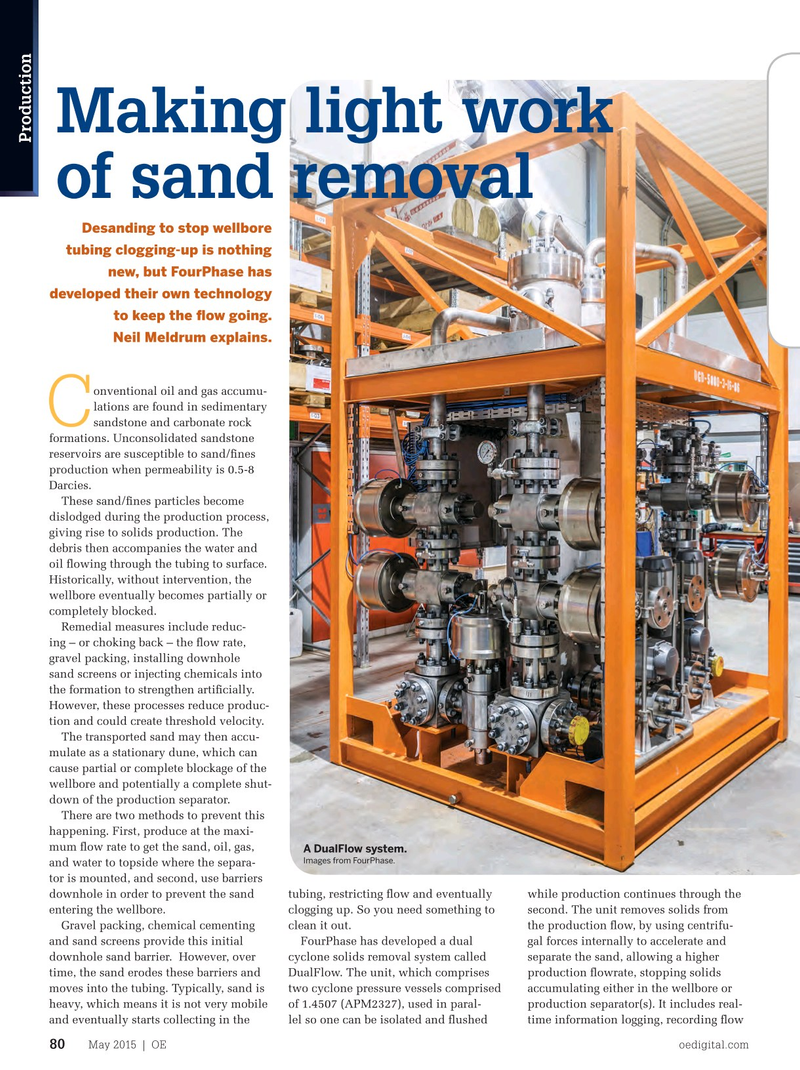
Page 78: of Offshore Engineer Magazine (May/Jun 2015)
Read this page in Pdf, Flash or Html5 edition of May/Jun 2015 Offshore Engineer Magazine
Making light work
Eyebrow Production of sand removal
Desanding to stop wellbore tubing clogging-up is nothing new, but FourPhase has developed their own technology to keep the ? ow going.
A DualFlow system overview.
Neil Meldrum explains.
rates, pressure, temperature, and solids removed. Its dynamic range is 20 micron onventional oil and gas accumu- to 5mm solids. Standard DualFlow units lations are found in sedimentary are rated to either 5000psi or 10,000psi as
C sandstone and carbonate rock required. formations. Unconsolidated sandstone The system, which weighs 8500kg and reservoirs are susceptible to sand/? nes has a 200 x 200 x 328 cm footprint, has production when permeability is 0.5-8 a smaller footprint, at one third of the
Darcies. size of existing units on the market; uses
These sand/? nes particles become Super Duplex piping and a carbon steel dislodged during the production process, frame; and is 99.8% ef? cient. FourPhase giving rise to solids production. The also supplies its own X-Flow choke debris then accompanies the water and manifold, which has directional control oil ? owing through the tubing to surface. and a reversible ? owpath. It can be used
Historically, without intervention, the for well clean-up or kick start applica- wellbore eventually becomes partially or tions or permanently installed in the completely blocked. production facility.
Remedial measures include reduc- Production from the well is routed ing – or choking back – the ? ow rate, to the DualFlow unit and the ? ow rate gravel packing, installing downhole increased so as to allow enough velocity sand screens or injecting chemicals into and energy in the ? uid in order to lift the the formation to strengthen arti? cially. accumulated sand/? nes particles from
However, these processes reduce produc- the wellbore. The weight of the accumu- tion and could create threshold velocity. lated solids in the unit is typically 20-200
The transported sand may then accu- kilos/hr – ? owrate dependent.
mulate as a stationary dune, which can Norwegian energy giant Statoil chose cause partial or complete blockage of the FourPhase’s solution for the Gullfaks C wellbore and potentially a complete shut- offshore installation, in the Norwegian down of the production separator. Sea. Gullfaks started production in 1986.
There are two methods to prevent this Initial recoverable reserves were esti- happening. First, produce at the maxi- mated to be 2.1 billion bbl. mum ? ow rate to get the sand, oil, gas, Production peaked at 605,000 b/d in
A DualFlow system.
Images from FourPhase.
and water to topside where the separa- 1994 and is now about 110,000 b/d, with tor is mounted, and second, use barriers a 62% recovery rate. Intended production while production continues through the tubing, restricting ? ow and eventually downhole in order to prevent the sand recovery is aimed at 74%, with part of second. The unit removes solids from clogging up. So you need something to entering the wellbore. this being achieved by using sand control the production ? ow, by using centrifu- clean it out. Gravel packing, chemical cementing technology.
Gullfaks C is known for its challenging and sand screens provide this initial FourPhase has developed a dual gal forces internally to accelerate and solids production, which has resulted in downhole sand barrier. However, over cyclone solids removal system called separate the sand, allowing a higher reduced production rates due to well- time, the sand erodes these barriers and DualFlow. The unit, which comprises production ? owrate, stopping solids bores having to be choked back and even moves into the tubing. Typically, sand is two cyclone pressure vessels comprised accumulating either in the wellbore or shut in. Choking back means having to heavy, which means it is not very mobile of 1.4507 (APM2327), used in paral- production separator(s). It includes real- reduce wellbore ? owrate to reduce the and eventually starts collecting in the lel so one can be isolated and ? ushed time information logging, recording ? ow
May 2015 | OE oedigital.com 80 080_OE0515_ProdOps3_FourPhase.indd 80 4/20/15 6:18 PM

 77
77

 79
79